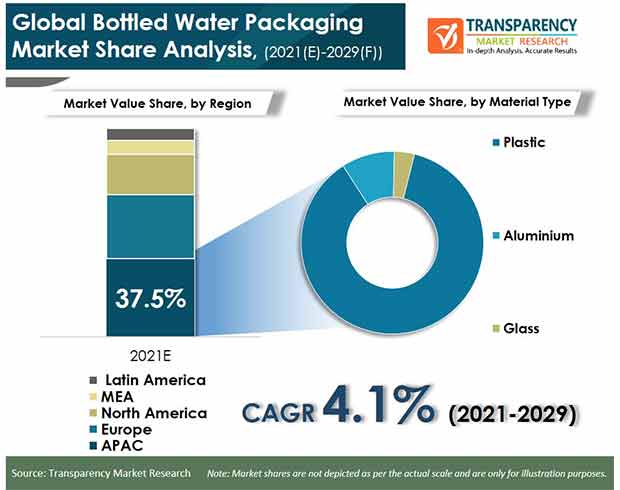Bottled Water Packaging Market: Share, Growth By Top Company, Region, Applications, Drivers, Trends,Forecast To 2021-2029
Bottled Water Packaging Market: Introduction
Transparency Market Research delivers key insights for the bottled water packaging market in its published report, which include global industry analysis, size, share, growth, trends, and forecast for 2021–2029. In terms of growth, the global bottled water packaging market is projected to witness a rapid growth rate by the end of 2029, owing to increasing scope of hygiene packaging in end-use industries such as personal care, food & beverage, healthcare, and others. About this, TMR offers detailed insights and forecasts in the bottled water packaging market report.

Safe drinking water is extremely essential for human health. According to the WHO, 785 million people in the world lack basic drinking water services. Contaminated drinking water can breed grounds several diseases such as diarrhea, cholera, dysentery, typhoid, and polio. Bottled water is often considered a source of clean and hygienic drinking water. Bottled water packaging is believed to be started in the 19th Century. Due to technological innovations and mechanization, larger quantities of bottles could be packed and distributed, which led to the popular U.S. brand Saratoga Springs selling more than 7 million water bottles in 1850.
Customer preferences for water are slowly shifting toward bottled water due to health issues. Amid present pandemic situations, bottled water packaging could be considered the safest and most hygienic water option for people across the world since it is untouched and the packaging makes carrying water easier. The consumption of water has overall increased across the world due to health benefits and immunity building. Drinking plenty of hygienic water could lead to easy recovery from the virus and help flush out toxins from the body. Bottled water packaging is expected to gain more value in 2021 due to these reasons.
Planning to lay down future strategy? Perfect your plan with our report brochure here@ https://www.transparencymarketresearch.com/sample/sample.php?flag=B&rep_id=20234
Increasing Food Commercialization to Boost Bottled Water Packaging Market
In most countries, bottled water is regarded as a standard drinking water and used to produce various food articles and consumable goods. Since food industries in most countries are subjected to strict rules, usage of standard water becomes mandatory for food processing companies to abide by the standard procedures. Bottled water packaging ensures the same taste is maintained across the country. Bottled water plants usually have contracts with these food chains and supply them water, which ensures they don’t run out of business anytime. This is a huge benefit for the bottled water packaging market. Thus, increasing food commercialization and the onset of newer brands are set to boost the bottled water packaging market.
Bottled Water Packaging Market Helps Curb Water Contamination
Bottled water usually undergoes a 10-step treatment in the water plant to enhance the quality of water and remove any unwater particles present in them. Bottled water packaging is safer than tap water, as it reduces any chances of water pollution or infection. Bottled water packaging helps to reduce water contamination by treating it with chemicals that help safeguard water from contamination. Moreover, packaging helps the water to stay away from any kind of dust or dirt outside. Increasing water-borne diseases and water contamination has forced people to switch to packaged drinking water. Mineral-rich bottled water helps to fight bone diseases, provides the body with essential nutrients, and replenishes electrolytes in the body. It also helps to flush out toxins and supports essential physical functions in the body.
Despite all the positive factors and usability of the bottled water packaging market, issues such as degradability of bottles in packaged water and increasing land waste might be few concerns that could restrain the bottled water packaging water in the forecast period. Most of these bottles are made from PET added with chemicals including methanol, aromatic hydrocarbons, and esters, which are toxic for human health.
Comments
Post a Comment